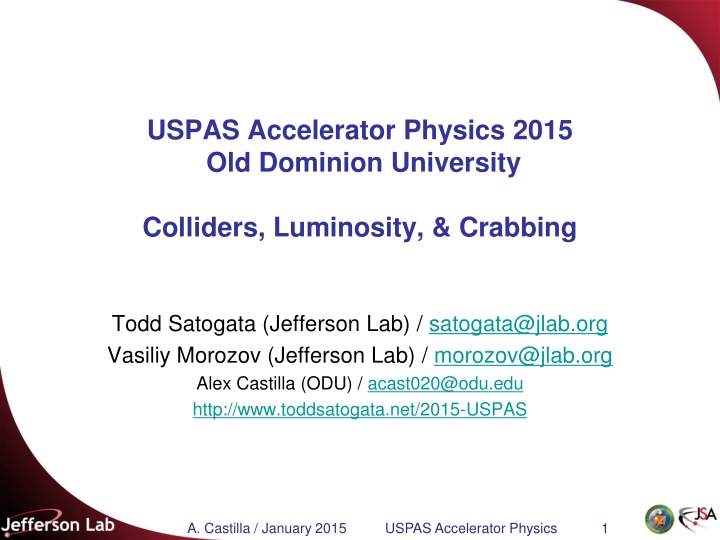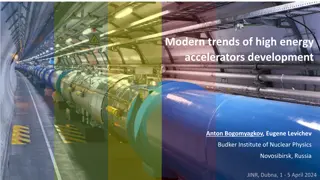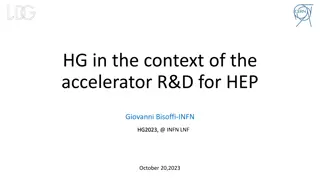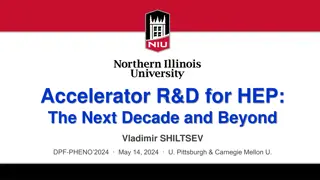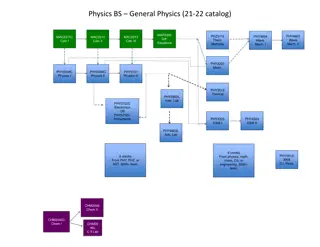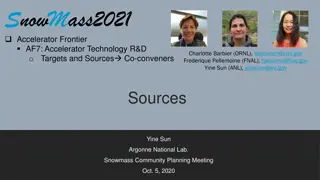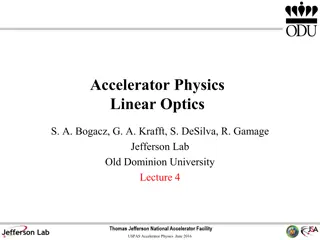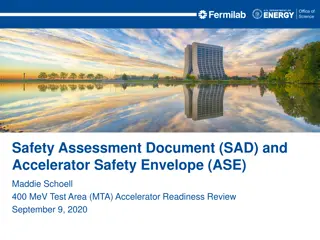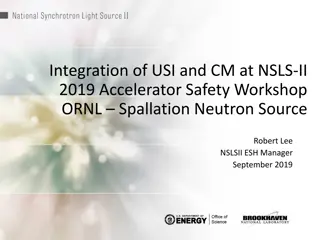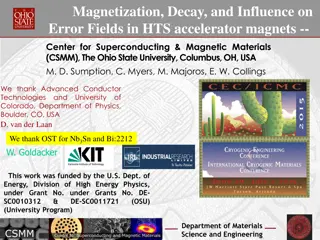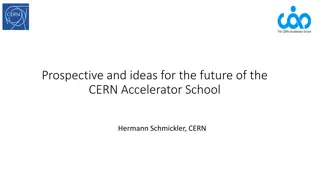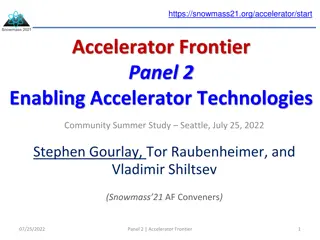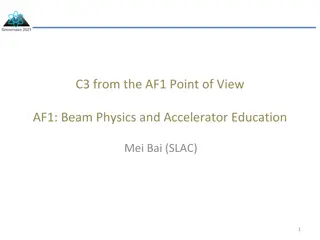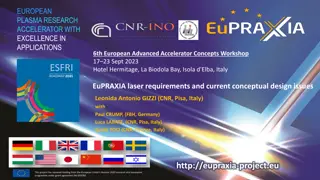USPAS Accelerator Physics 2015 at Old Dominion University
Dive into the world of collider physics with insights on colliders, luminosity, event rates, crabbing, and more from the USPAS Accelerator Physics 2015 at Old Dominion University. Explore the fundamentals of colliders, their optimization, and the significance of probing small entities. Uncover how accelerators enhance statistical resolution and the intricate processes involved in interaction rates. Join Todd Satogata, Vasiliy Morozov, and Alex Castilla on this enlightening journey through the realms of accelerator physics.
Download Presentation

Please find below an Image/Link to download the presentation.
The content on the website is provided AS IS for your information and personal use only. It may not be sold, licensed, or shared on other websites without obtaining consent from the author.If you encounter any issues during the download, it is possible that the publisher has removed the file from their server.
You are allowed to download the files provided on this website for personal or commercial use, subject to the condition that they are used lawfully. All files are the property of their respective owners.
The content on the website is provided AS IS for your information and personal use only. It may not be sold, licensed, or shared on other websites without obtaining consent from the author.
E N D
Presentation Transcript
USPAS Accelerator Physics 2015 Old Dominion University Colliders, Luminosity, & Crabbing Todd Satogata (Jefferson Lab) / satogata@jlab.org Vasiliy Morozov (Jefferson Lab) / morozov@jlab.org Alex Castilla (ODU) / acast020@odu.edu http://www.toddsatogata.net/2015-USPAS A. Castilla / January 2015 USPAS Accelerator Physics 1
Outline Colliders Why and where? Issues Accelerator Physics of Colliders Event rate Luminosity Looking at the luminosity Fixed target Colliders: Gaussian bunches, head-on Optimization knobs and complications Hourglass effect Crossing angle Crabbing A. Castilla / January 2015 USPAS Accelerator Physics 2
Colliders Where? STAR detector at RHIC, J.G. Cramer UW Colloquium 2002. Butchered slide from Steve Myers IPAC2012 New Orleans. A. Castilla / January 2015 USPAS Accelerator Physics 3
Colliders (2) Because they are super cool! Why? www.businessinsider.com Laurent Egli. True! But also: 2+ ?1+ ?2 2 ???= ?1+ ?2 Fixed target (?2= 0) ???= ?1+ ?2 Colliding beams (?1= ?2) 2?2+ 2?1? ???= A. Castilla / January 2015 USPAS Accelerator Physics 4
Probing small things SUSY?? ?? Higher energy higher resolution 1 ??? 125 G?? Weak nuclear force Proton and neutron Quarks, muon Nuclear states transitions ? =? 1 ??? ? 1 ??? Electron Transitions in the inner-shell atomic states 1 ??? Atomic states transitions 1 ?? Lattice vibration in solids (phonons) 1 ??? A. Castilla / January 2015 USPAS Accelerator Physics 5
Accelerator Basics of Colliders More events in time better statistic/resolution of the processes. ?? ??= ? ?? ?? ?? interactions per second, - - ?? interaction cross section (machine independent), - ? luminosity, relativistic invariant, independent of the interaction and very important- measurable. A. Castilla / January 2015 USPAS Accelerator Physics 6
Accelerator Basics of Colliders (2) *F. Zimmermann, SLAC Summer Institute (2012). A. Castilla / January 2015 USPAS Accelerator Physics 7
Shining Beam on a Fixed Target The interaction rate will be a function of: ?? ??= (????) ?? - ?? interaction cross section. ??= ????? - ? beam particles flux. ? - ?? target density. ? ? = ????? - ? target size. A. Castilla / January 2015 USPAS Accelerator Physics 8
Shining Beam on a Beam (Collider) The interaction rate will be a function of: ?? ??= (????) ?? ??= ????? - Then: ? ?????/? ? target = - ? bunch frequency. moving beam! - ?? number of particles per bunch. - ? beam transverse profile. A. Castilla / January 2015 USPAS Accelerator Physics 9
Collider Luminosity ?2 ?1 Per bunch crossing: = ? ?1?2 ?0 ????????0[?1?,?,?, ?0 ?2 ?,?,?,?0] Where ?0= ??. And ? is the kinematic factor 2?2. 2 ?1 ?2 ?1 ?2 Head-on collisions ( ?1= ?2), then ? = 2. For uncorrelated distributions: ? ?,?,?,?0 = ??? ??? ??? ?0 A. Castilla / January 2015 USPAS Accelerator Physics 10
Luminosity of Gaussian Bunches For two bunches with ?1 and ?2 particles respectively: ?2 ?1 ?0 1? ? = Where ? ?? are the rms horizontal/vertical beam sizes. No offset and head-on collision. https://en.wikipedia.org/wiki/Multiv ariate_normal_distribution A. Castilla / January 2015 USPAS Accelerator Physics 11
Luminosity of Gaussian Bunches (2) For two beams: = 2 ?1?2 ? ?? ????????0[ ?1?? ?1?? ?1?? ?0 ?2?? ?2?? ?2?? + ?0] The Gaussian distributions can be written: ?2 ( (? ?0)2 2??2) ; ( 2???2), ??? ?0 = 1 1 ???? = ??? 2?? ?? 2?? where ? = ?,? and ? = 1,2 indicates the bunch number. A. Castilla / January 2015 USPAS Accelerator Physics 12
Luminosity of Gaussian Bunches (3) Normal distributions are 0K for bunches in equilibrium. Not Gaussian? (most likely) numerical integration. Simplest case: Identical bunches: ?1?= ?2?, ?1?= ?2?, and ?1?= ?2? Even ?1? ?2? and ?1? ?2? can be easily calculated (we will keep ?1? ?2?). We will also consider no dispersion at the collision point. Let s try a bit of real-time math! A. Castilla / January 2015 USPAS Accelerator Physics 13
Luminosity of Gaussian Bunches (4) What happens to the bunch s shape here? ?2 ?1 1? ? = Where at the IP: Is this Again, for identical optimizable ? 2 ??,? ? and = ? beams, no crossing angle, ??,? = ?? no dispersion, no off-set. =?1?2??? 4? ?? ?? Then =?1?2??? 4????? A. Castilla / January 2015 USPAS Accelerator Physics 14
Turning Knobs for Luminosity Not head-on collisions (crossing angle ??). Beam deformations at IP (hour-glass effects). Desired or non-desired offsets. Dispersion at IP. More a complication rather than a knob? injector and beam-beam Strong coupling, etc. ?????? ? ? ? ? ?(??,?,? ,??) Reduction factor: hourglass effect, crossing angle = ?? total beam current energy and ? A. Castilla / January 2015 USPAS Accelerator Physics 15
Hourglass Effect ?-functions dependent on ?, usually: 2 ? ?(?) ? 1 + ? Then ???????? = ? ? : 2 ? (?) ? 1 + ? Results important if ?? ? . *Werner Herr, CAS-Lectures, Bulgaria (2010). A. Castilla / January 2015 USPAS Accelerator Physics 16
Hourglass Effect (2) So the luminosity reduction factor: 2 ? ?? ?? ?? ? ?? ?? 0 = ? ???? ?? = 0 ?? (??,?,? ,??) Enigmatic dependency mentioned before! A. Castilla / January 2015 USPAS Accelerator Physics 17
A Bit More Interesting Case (Crossing Angle) x s ?2 ?1 ?? 2 ?? 2 Reduce parasitic collisions. Physical space for magnets. Better detector resolution. A. Castilla / January 2015 USPAS Accelerator Physics 18
Rotating Reference Frames (for each bunch) x ?1 s ?? 2 ?? 2 ?1 ?2 ?2 ?1= ?cos?? 2+ ?sin?? 2 , ?1= ?cos?? 2 ?sin?? 2 . ?2= ? cos?? 2+ ?sin?? 2 , ?2= ?cos?? 2 ? sin?? 2 . A. Castilla / January 2015 USPAS Accelerator Physics 19
For the Distributions in the New Systems For two beams: = 2 ?1?2 ? ?? ????????0[ ?1??1?1??1?1??1 ?0 ?2??2?2??2?2??2+ ?0] Now we will use: ?2 ?? ? ? ? ? ??? ??2+??+?= ?? With some approximations: then: 2 fairly small (mrad ~10 2deg), ??2~tan ??2~ ??2 sin A. Castilla / January 2015 USPAS Accelerator Physics 20
For the Distributions in the New Systems (2) ?? Some more approximations since 2 is small: ??2~tan ??2~ ??2; sin ?? discarding ???sin? is ?? ??? tan 2 ; ? + ? 4 ?? ??sin? ?? ?? 2. 2 2 And so the result is slightly different: ?1?2??? 1 = ?? 2 4?? ?? ?(??,?,? ,??) ?? ??tan?? 1+ 2 A. Castilla / January 2015 USPAS Accelerator Physics 21
Crossing Angle w/o Correction ?? IP A. Castilla / January 2015 USPAS Accelerator Physics 22
The Crabbing Concept *R. Palmer, SLAC-PUB-4707 (1988). . A. Castilla / January 2015 USPAS Accelerator Physics 23
RF Transverse Deflection ??? cos?? + ???? sin?? ??= ?? ? ? ?? ? A. Castilla / January 2015 USPAS Accelerator Physics 24
RF Transverse Deflection(special case) ??? cos?? + ???? sin?? ??= ?? ? ? ?? ? A. Castilla / January 2015 USPAS Accelerator Physics 25
Local Crab Crossing Correction ?? IP A. Castilla / January 2015 USPAS Accelerator Physics 26
Jefferson Labs Medium Energy Electron-Ion Collider A. Castilla / January 2015 USPAS Accelerator Physics 27
The MEIC at JLab Deep inelastic ?? ?? scattering. Y. Zhang, et al. arXiv:1209.0757v2 (2012). A. Accardi, et al. arXiv:1110.1031v1 (2011). ( ? = 20 70 ???)and~???? ?? ?? ? luminosity. A. Castilla / January 2015 USPAS Accelerator Physics 28
The MEIC Layout Ions IP ?1?2??? 1 Electrons = ?? 2 4?? ?? ?? ??tan?? 1+ 2 Electrons Ions IP s V. S. Morozov , MEIC study group (2013). A. Castilla / January 2015 USPAS Accelerator Physics 29
The MEIC Luminosity Approach Short bunches for both species. Small transverse emittance. Ultrahigh collision frequency CW beams. Staged electron cooling. Small final focusing ? . Large beam-beam tune shift. Crab crossing. A. Castilla / January 2015 USPAS Accelerator Physics 30
MEIC Crabbing Requirements High repetition. Big crossing angle. ? ? ???tan?? 2 ??= ? ?? ??? ?? Parameter Units GeV MHz mrad cm m MV Electron 5 Proton 60 Beam energy ?? Bunch frequency ?? Crossing angle ?? Betatron function at the IP ?? Betatron fn. at the crab cavity ?? Integrated kicking voltage ?? 750.0 50 10 ? 300 1.35 1400 8 A. Castilla / January 2015 USPAS Accelerator Physics 31
Transverse Kick (e.g. 750 MHz SRFD) ??? cos?? + ???? sin?? ??= ?? ? ? ?? ?2 = 0.2 ?? Electric Field Magnetic Field ??= ?? ??? = 1 ?? ??,? = 0.2 ?? ??,? = 0.4 ?? A. Castilla / January 2015 USPAS Accelerator Physics 32
Most of the Content Borrowed from W. Herr Concepts of luminosity for particle colliders CAS-Lectures, Varna, Bulgaria 2010. F. Zimmermann LHC: The machine , SLAC Summer Institute 2012. J. G. Cramer Surprises from RHIC UW Phys. Dept. Colloquium 2002. And many more A. Castilla / January 2015 USPAS Accelerator Physics 33
